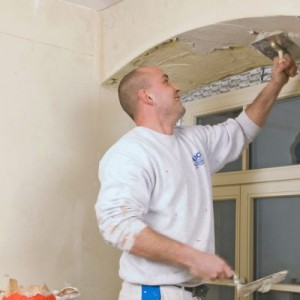The water retention rate of plastering gypsum slurry is related to the content of water-retaining agent, retarder and water ratio. Increasing the amount of water-retaining agent can increase the water retention rate, delay the setting time, and have a retarding effect, but it affects the strength. This is because: as the content of retarder and water-retaining agent increases, the water-solid ratio changes and a large amount of water is generated on the surface of the slurry, which not only increases the porosity inside the hardened slurry, but also forms a crystalline structure in the entire slurry. The amount of hydrate required for the net has also increased significantly, so there is less interlacing between the precipitated dihydrate gypsum crystals, which reduces the bonding strength between the particles, which is the main reason for the decrease in strength. The better the retardation effect, the slower the setting and hardening speed, and the more the strength of the hardened body decreases.
What effect does construction sand have on the performance of plastering plaster?
Construction sand is the main aggregate of the bottom plaster plaster. The gradation of sand, the size of the mud content and the mixing ratio of the bottom plaster are very important to the performance of the bottom plaster. The undesirable sand gradation and mud content A large amount of construction sand will shorten the setting time of plaster plaster, poor bonding performance, and reduce compressive strength. It will cause greater shrinkage during the drying process, resulting in hollowing, cracking, and powdering of the plaster bottom layer. Phenomenon, general plastering gypsum should use medium-fine sand that meets the construction sand standard, with a mud content of less than 6%. The mixing ratio of the filling should be designed according to the product formula, and the matching can be determined only when the technical indicators of the industry standard can be met through experiments. In contrast, we must not add too much aggregate in order to reduce costs and affect product quality.
What are the factors that determine the setting time of composite plaster plaster?
It is not the calcination time, calcination method, or subsequent processing that determines the setting time of composite plaster gypsum. One of the most important reasons for shortening the setting time is the content of dihydrate particles surrounded by hemihydrate or anhydrous gypsum in the composite plaster plaster. Since the dihydrate particles are surrounded by other variants of calcium sulfate, their influence is not significant; if this composite plaster plaster is ground finer, the dihydrate particles will get rid of the outer surrounding , Their influence is obvious; compared with unground composite plaster plaster, the setting time is also shortened.
What are the advantages of plastering plaster for indoor aerated concrete walls?
Plastering with plastering plaster not only overcomes the prone to hollowing and cracking of aerated concrete walls caused by traditional plastering methods, but also has the following significant technical, economic and social benefits.
(1) The construction workability is good, the adhesive force is strong, and there is micro-expansion, so the thickness of the plastering layer can be thinner and the landing ash is less, which saves costs and can achieve on-site civilized construction:
(2) The slurry density is small, which can reduce the bulk density of the building (the plastering area is 1.0 to 1.5 times that of the traditional plastering).
(3) Early strength and fast hardening, shortening the process difference and construction period, can be constructed at an ambient temperature of -5°C and above, saving a lot of winter construction costs.
(4) It belongs to Class A fireproof material, and has good sound insulation and heat preservation performance. It is the preferred material for safe and energy-saving living environment.
(5) The plastering layer is compact and smooth, with low alkalinity, providing an excellent base layer for surface decoration, reducing the amount of surface decoration and decoration materials, and reducing the amount of paint by about 1/3.
(6) Plastering gypsum has good water retention and cohesiveness, and moisture will not be sucked away by the aerated concrete wall in a short time, ensuring complete hydration of the plastering slurry. The characteristics of thermal conductivity, deformation coefficient and volumetric expansion during hardening can be coordinated with aerated concrete to ensure that the plaster layer will not powder, hollow, or crack. After the plastering gypsum is set, its strength increases with the decrease of the moisture content, which can be coordinated with the slow water absorption of aerated concrete to produce good overall strength. Plastering gypsum also has good moisture removal properties. After hardening, it has a good moisture removal effect on the drying of aerated concrete, avoiding various disadvantages caused by uneven water content in the aerated concrete.
Post time: Feb-21-2021





